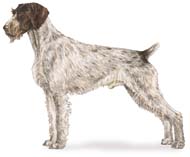THE GERMAN WIREHAIRED POINTER
(The American Kennel Clubs Standard and Description)
 General Appearance
General Appearance
The German Wirehaired Pointer is a well
muscled, medium sized dog of
distinctive appearance. Balanced in size
and sturdily built, the breed's most
distinguishing characteristics are its
weather resistant, wire-like coat and its
facial furnishings. Typically Pointer in
character and style, the German
Wirehaired Pointer is an intelligent,
energetic and determined hunter.
Size, Proportion, Substance
The height of males should be from 24 to 26 inches at the withers.
Bitches are smaller but not under 22 inches. To insure the working quality
of the breed is maintained, dogs that are either over or under the specified
height must be severely penalized. The body is a little longer than it is
high, as ten is to nine. The German Wirehaired Pointer is a versatile
hunter built for agility and endurance in the field. Correct size and balance
are essential to high performance.
Head
The head is moderately long. Eyes are brown, medium in size, oval in
contour, bright and clear and overhung with medium length eyebrows.
Yellow eyes are not desirable. The ears are rounded but not too broad
and hang close to the head. The skull broad and the occipital bone not
too prominent. The stop is medium. The muzzle is fairly long with nasal
bone straight, broad and parallel to the top of the skull. The nose is dark
brown with nostrils wide open. A spotted or flesh colored nose is to be
penalized. The lips are a trifle pendulous but close to the jaw and
bearded. The jaws are strong with a full complement of evenly set and
properly intermeshing teeth. The incisors meet in a true scissors bite.
Neck, Topline, Body
The neck is of medium length, slightly arched and devoid of dewlap. The
entire back line showing a perceptible slope down from withers to croup.
The skin throughout is notably tight to the body. The chest is deep and
capacious with ribs well sprung. The tuck-up apparent. The back is short,
straight and strong. Loins are taut and slender. Hips are broad with the
croup nicely rounded. The tail is set high, carried at or above the
horizontal when the dog is alert. The tail is docked to approximately
two-fifths of its original length.
Forequarters
The shoulders are well laid back. The forelegs are straight with elbows
close. Leg bones are flat rather than round, and strong, but not so heavy
or coarse as to militate against the dog's natural agility. Dewclaws are
generally removed. Round in outline, the feet are webbed, high arched
with toes close, pads thick and hard, and nails strong and quite heavy.
Hindquarters
The angulation of the hindquarters balances that of the forequarters. The
thighs are strong and muscular. The hind legs are moderately angulated
at the stifle and hock and, as viewed from behind, parallel to each other.
Dewclaws are generally removed. Feet as in front.
Coat
The functional wiry coat is the breed's most distinctive feature. A dog
must have a correct coat to be of correct type. The coat is weather
resistant and, to some extent, water-repellent. The undercoat is dense
enough in winter to insulate against the cold but is so thin in summer as
to be almost invisible. The distinctive outer coat is straight, harsh, wiry
and flat lying, and is from one to two inches in length. The outer coat is
long enough to protect against the punishment of rough cover, but not so
long as to hide the outline of the dog. On the lower legs the coat is
shorter and between the toes it is of softer texture. On the skull the coat
is naturally short and close fitting. Over the shoulders and around the tail
it is very dense and heavy. The tail is nicely coated, particularly on the
underside, but devoid of feather. Eyebrows are of strong, straight hair.
Beard and whiskers are medium length. The hairs in the liver patches of a
liver and white dog may be shorter than the white hairs. A short smooth
coat, a soft woolly coat, or an excessively long coat is to be severely
penalized. While maintaining a harsh, wiry texture, the puppy coat may
be shorter than that of an adult coat. Coats may be neatly groomed to
present a dog natural in appearance. Extreme and excessive grooming to
present a dog artificial in appearance should be severely penalized.
Color
The coat is liver and white, usually either liver and white spotted, liver
roan, liver and white spotted with ticking and roaning or solid liver. The
head is liver, sometimes with a white blaze. The ears are liver. Any black
in the coat is to be severely penalized.
Gait
The dog should be evaluated at a moderate gait. The movement is free
and smooth with good reach in the forequarters and good driving power in
the hindquarters. The topline should remain firm.
Temperament
Of sound, reliable temperament, the German Wirehaired Pointer is at
times aloof but not unfriendly toward strangers; a loyal and affectionate
companion who is eager to please and enthusiastic to learn.
Approved July 9, 1985
Reformatted May 14, 1989
We have included links and pages to help you find a Puppy or Breeder
or to simply help people learn more about this breed.
We invite Clubs, Organizations and Reputable Breeders to submit
links and information to help make this site as informative as possible.
CONTACT: Stacy at
SPORTING BREEDS CENTRAL
Sporting Breeds Central GERMAN WIREHAIRED POINTER Breeders Directory and Litter Ads
The GERMAN WIREHAIRED POINTER Parent Club
GERMAN WIREHAIRED POINTER Rescue Organizations
GERMAN WIREHAIRED POINTER Kennel Clubs
MAIN PAGE
 General Appearance
General Appearance